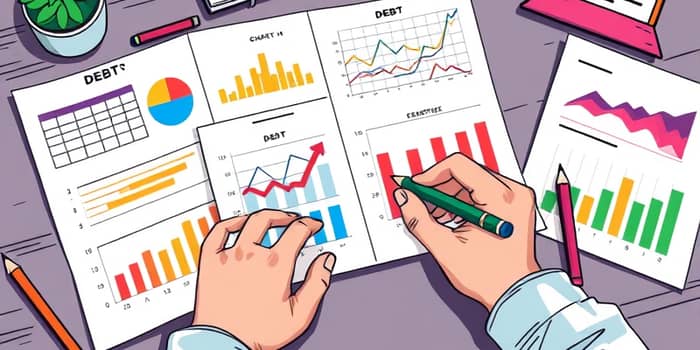
Staying on top of debt can feel overwhelming. Yet, by implementing a structured monthly check-in, you gain clarity, control, and confidence as you chip away at what you owe. This article guides you step-by-step to build a system that not only tracks balances but fosters lasting financial habits and sustains momentum through each phase of repayment.
With a reliable routine, you transform abstract numbers into tangible progress. As you update your records and reflect on changes every month, you celebrate wins, identify challenges, and make informed decisions for the coming weeks.
Regular monitoring of debts is not merely record-keeping—it’s an act of empowerment. By capturing your balances and payments monthly, you develop a clear picture of your financial trajectory. When you see interest accrual and principal reduction side by side, you can adjust payments to minimize costs and shorten payoff periods.
Consistency ensures you spot anomalies early—missed payments, unexpected fees, or interest rate hikes. Armed with accurate data, you communicate more effectively with creditors, potentially negotiating lower rates or alternative payment arrangements.
Your journey begins with compiling every debt account in one place. This complete debt snapshot becomes the foundation of your plan. Whether you use a spreadsheet, an app, or a paper ledger, include key fields:
For example, consider the table below illustrating a simple debt profile:
By listing debts side by side, you gain insight into how each liability impacts your budget and which accounts warrant immediate attention.
Falling behind often stems from missed due dates. Combat this by creating a bill payment schedule that aligns with your income flow and spending habits. Map out each payment date on a calendar—digital or paper—and set reminders a few days in advance.
Integrate your debt tracker with this schedule. Color coding can help: red for high-interest accounts, yellow for moderate, green for low. When you glance at your calendar, you immediately see where to focus your cash allocation for the month.
Selecting the right payoff approach is critical. One popular method is the Avalanche Method, where you prioritize debts with the highest interest rates to minimize total interest paid over time. Alternatively, the Snowball Method focuses on eliminating the smallest balances first, providing quick emotional victories and sustaining motivation. You may also craft a hybrid approach that balances rapid interest savings with early account closures, tailoring the strategy to your financial and emotional needs.
Remember to consider secured debts (like mortgages or auto loans) and mandatory obligations (federal taxes) as priorities, to protect essential assets and avoid penalties.
At the end—or start—of each month, set aside dedicated time for your debt review. Follow this sequence:
By adhering to this routine, you establish real-time progress tracking, transforming debt payoff from a vague promise into a series of measurable steps.
Numbers alone can be dry; visuals bring them to life. Use charts or graphs to display your balance decline over consecutive months. A downward-sloping line or descending bar chart offers immediate gratification and pushes you to maintain momentum.
Digital apps often include dashboards, but you can create your own in a spreadsheet. Add color gradients—lighter shades for higher balances, deeper hues as you pay down each account. This approach taps into your reward centers every time you update your data.
Pair visual tracking with small celebrations when milestones are met. For example, treat yourself modestly once you’ve paid off 25% of one debt, then plan a larger reward at 50% or 75% completion.
Life is unpredictable. If expenses surge or income drops, revisit your budget allocations. You might need to temporarily reduce discretionary spending, reallocate funds from lower-priority repayments to essential accounts, or switch repayment methods if progress stalls. Don’t view setbacks as failures but as data points prompting course corrections. By flexibly adapting your approach, you maintain forward momentum even when circumstances change.
Modern financial apps can automate much of this process. Set up calendar alerts, automatic payments, and spreadsheet formulas to calculate interest and track totals. Many platforms allow you to link accounts so balances update automatically, reducing manual entry errors.
Joining a community—whether an online forum, social media group, or local accountability circle—provides encouragement and fresh ideas. Sharing your journey fosters accountability and may introduce you to creative tactics you haven’t considered. Engaging with a financial advisor can also be valuable if your debt situation is complex, offering personalized strategies and negotiation assistance.
Adopting a monthly check-in habit does more than pay down debt; it cultivates discipline and financial literacy. As you master the process, you’ll gain peace of mind knowing you control your money rather than being controlled by it.
Over time, the skills you hone—strategic planning, data analysis, adaptive budgeting—will serve you well in all areas of personal finance. From saving for emergencies to investing for retirement, the foundation you build today unlocks future opportunities.
Start your first check-in today. Compile your debt profile, pick a strategy, and schedule your review. With each passing month, you’ll see progress not just on paper but in your sense of achievement and empowerment.
References













